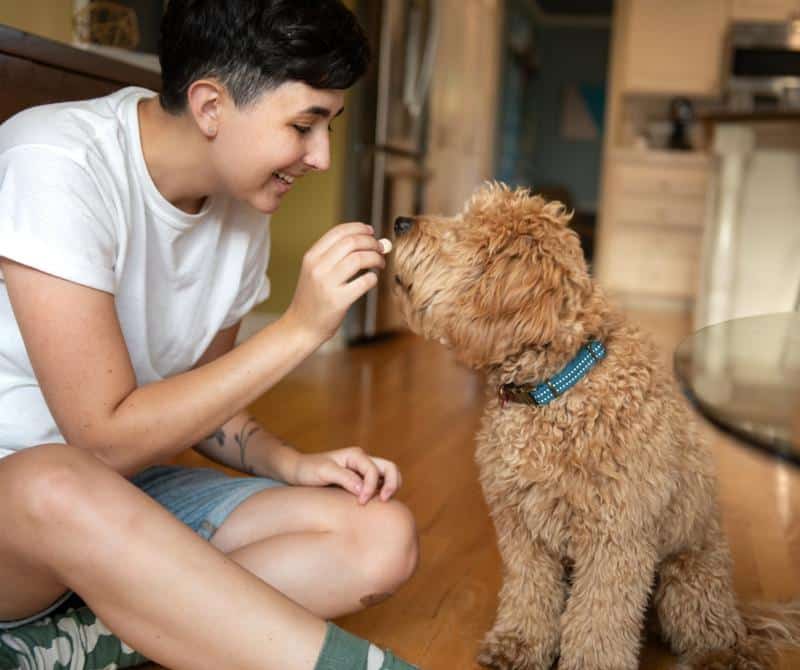
Introducing a puppy into your family is a journey filled with joy, challenges, and unforgettable moments. One of the fundamental keys to nurturing a healthy, happy, and well-behaved dog is positive puppy training. This method focuses on rewarding desired behaviors, which encourages your puppy to repeat them.
It’s a kind, effective approach that strengthens the bond between you and your puppy. This article aims to guide laypeople through the process of positive puppy training, from the crucial early weeks up to the one-year mark, emphasizing the importance of gentle handling and diverse exposures from birth.
Understanding Positive Training
Positive training is rooted in the science of animal behavior and learning. It uses rewards (like treats, praise, or play) to promote good behavior, rather than punishing unwanted behavior, which can lead to fear or aggression. This approach fosters a positive relationship between you and your puppy, built on mutual trust and understanding.
The Timeline of Training: From 8 Weeks to 1 Year
From Birth to 8 Weeks: The Foundation
Puppies begin learning from the moment they’re born, through interactions with their mother and littermates. Gentle handling by humans during this stage is critical, as it helps puppies become comfortable with human touch. Breeders or caregivers should also start exposing puppies to various stimuli (sounds, surfaces, and experiences) in a controlled manner to start their socialization process positively.
8 to 12 Weeks: Socialization and Basic Commands
When puppies join their new families, the focus should be on socialization and basic commands. This age is a critical period for socialization; exposure to different people, pets, environments, and sounds in a positive way can reduce fearfulness and aggression later on.
- Focus Areas: Crate training, house training, and basic commands like “sit,” “stay,” and “come.”
- Training Tips: Keep training sessions short, fun, and reward-based. Use treats and praise to encourage desired behaviors.
12 Weeks to 6 Months: Building on the Basics
As your puppy grows, continue reinforcing basic commands and introduce more complex ones. Start leash training, and gradually increase the complexity and duration of training sessions.
- Focus Areas: Leash training, preventing biting and chewing, and continuing socialization.
- Training Tips: Introduce a variety of walking situations and environments to make leash training more effective. Provide appropriate chew toys to redirect biting.
6 Months to 1 Year: Refining and Expanding Skills
During this period, puppies enter adolescence, which can bring new challenges, including testing boundaries. Continue to reinforce training through positive reinforcement, and consider starting more advanced training or dog sports.
- Focus Areas: Advanced commands, recall in distracting environments, and polite behavior with humans and other dogs.
- Training Tips: Maintain patience and consistency. Engage in activities that challenge your puppy both physically and mentally, like agility or advanced obedience classes.
Key Components of Positive Puppy Training
1. Consistency: Everyone in the household should use the same commands and rewards to avoid confusing your puppy.
2. Timing: Immediate rewards are crucial for your puppy to make the connection between their behavior and the positive outcome.
3. Patience: Puppies learn at their own pace. Patience and positive reinforcement are key to building their confidence and abilities.
4. Training Sessions: Keep them short, engaging, and fun. Several short sessions throughout the day are more effective than one long session.
5. Socialization: Expose your puppy to various situations, people, and other animals gently and gradually to build their confidence and sociability.
The Importance of Early Exposure and Gentle Handling
From birth, puppies benefit immensely from gentle handling and exposure to a wide range of stimuli. This early exposure helps puppies become adaptable and less fearful as they grow. It lays the groundwork for a well-adjusted dog who is comfortable in various situations, from encountering strangers to hearing loud noises.
Further Reading
- Potty Training: Strategies for a clean home and a well-trained puppy, focusing on consistency and positive reinforcement.
- Leash Training: Tips for enjoyable walks, addressing pulling and distractions, and encouraging leash manners.
- Preventing Common Behavioral Issues: Addressing biting, barking, and chewing through positive reinforcement techniques.
- Advanced Obedience: Building on basic commands to teach more complex behaviors and tricks.
- Socialization Strategies: Detailed guides on safely introducing your puppy to the world.
Positive puppy training is a rewarding approach that fosters a strong bond between you and your puppy based on trust and mutual respect. By understanding the key principles and timeline for training, from gentle handling from birth to refining skills up to one year old, you can set the foundation for a well-behaved, happy dog. Remember, the journey of raising a puppy is filled with learning opportunities and moments of joy. Embrace each stage with patience, consistency, and positive reinforcement,
